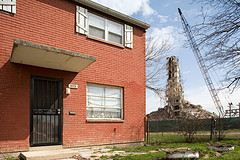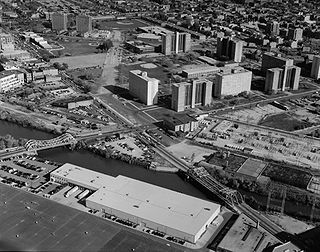
Cabrini–Green Homes was a Chicago Housing Authority (CHA) public housing project on the Near North Side of Chicago, Illinois. The Frances Cabrini Rowhouses and Extensions were south of Division Street, bordered by Larrabee Street to the west, Orleans Street to the east and Chicago Avenue to the south, with the William Green Homes to the northwest.

Robert Taylor Homes was a public housing project in the Bronzeville neighborhood on the South Side of Chicago, Illinois from 1962 to 2007. The largest housing project in the United States, it consisted of 28 virtually identical high-rises, set out in a linear plan for two miles, with the high-rises regularly configured in a horseshoe shape of three in each block. It was located along State Street between Pershing Road and 54th Street, east of the Dan Ryan Expressway. The project was named for Robert Rochon Taylor (1899–1957), an African-American activist and the first African American chairman of the Chicago Housing Authority (CHA). It was a part of the State Street Corridor which included other CHA housing projects: Stateway Gardens, Dearborn Homes, Harold Ickes Homes, and Hilliard Homes.
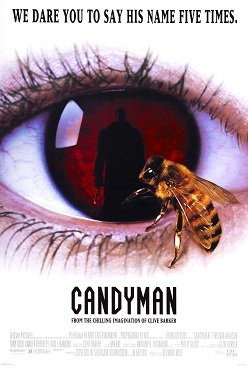
Candyman is a 1992 American gothic supernatural horror film, written and directed by Bernard Rose and starring Virginia Madsen, Tony Todd, Xander Berkeley, Kasi Lemmons, and Vanessa E. Williams. Based on Clive Barker's short story "The Forbidden", the film follows a Chicago graduate student completing a thesis on urban legends and folklore, which leads her to the legend of the "Candyman", the ghost of an African-American artist and the son of a slave who was murdered in the late 19th century for his relationship with the daughter of a wealthy white man.

Little Italy, sometimes combined with University Village into one neighborhood, is on the Near West Side of Chicago, Illinois. The current boundaries of Little Italy are Ashland Avenue on the west and Interstate 90/94 on the east, the Eisenhower Expressway on the north and Roosevelt to the south. It lies between the east side of the University of Illinois at Chicago campus in the Illinois Medical District and the west side of the University of Illinois at Chicago campus. The community was once predominantly Italian immigrants but now is made up of diverse ethnic and socio-economic backgrounds as a result of immigration, urban renewal, gentrification and the growth of the resident student and faculty population of the University of Illinois at Chicago (UIC). Its Italian-American heritage is primarily evident in the Italian-American restaurants that once lined Taylor Street. The neighborhood is home to the National Italian American Sports Hall of Fame as well as the historic Roman Catholic churches Our Lady of Pompeii, Notre Dame de Chicago, and Holy Family.

Dantrell Davis was an African-American boy from Chicago, Illinois, who was murdered in October 1992. Davis was walking to school with his mother in the Cabrini-Green housing projects when he was accidentally shot by Anthony Garrett, a member of a local street gang who intended to shoot a rival. Dantrell's death sparked an increased awareness of the extensive violence occurring in Chicago's inner-city projects, and led to the first street gang truce in Cabrini–Green, which lasted for three years. Garrett was convicted of first-degree murder for Davis' death, and received a 100-year sentence.
HOPE VI is a program of the United States Department of Housing and Urban Development. It is intended to revitalize the most distressed public housing projects in the United States into mixed-income developments. Its philosophy is largely based on New Urbanism and the concept of defensible space.
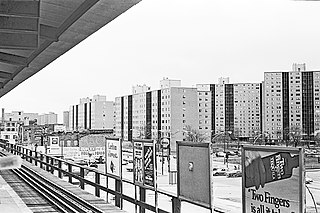
Stateway Gardens was a Chicago Housing Authority (CHA) public housing project in the Bronzeville neighborhood on the South Side of Chicago, Illinois, alongside the Dan Ryan Expressway just north of the former Robert Taylor Homes, and part of the State Street Corridor that also included Dearborn Homes, Harold Ickes Homes and Hillard Homes. Stateway Gardens consisted of mid- and high-rise apartment buildings.
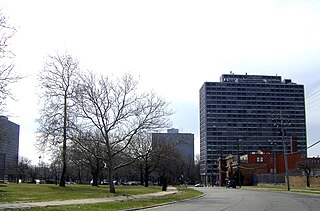
Lafayette Park is a neighborhood located east of Downtown Detroit. It contains a residential area of some 4,900 people and covers 0.07 sq mi.

Cermak Road, also known as 22nd Street, is a 19-mile, major east–west street on Chicago's near south and west sides and the city's western suburbs. In Chicago's street numbering system, Cermak is 2200 south, or twenty-two blocks south of the baseline of Madison Street. Normally, one mile comprises eight Chicago blocks, but the arterial streets Roosevelt Road, formerly named Twelfth Street and at 1200 South, and Cermak Road were platted before the eight-blocks-per-mile plan was implemented. Roosevelt Road is one mile south of Madison Avenue and there are twelve blocks within that mile. Cermak Road is two miles south of Madison Avenue and there are ten blocks within the mile between Roosevelt and Cermak Roads.
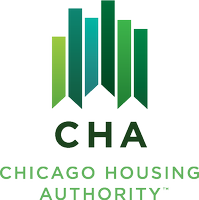
The Chicago Housing Authority (CHA) is a municipal corporation that oversees public housing within the city of Chicago. The agency's Board of Commissioners is appointed by the city's mayor, and has a budget independent from that of the city of Chicago. CHA is the largest rental landlord in Chicago, with more than 50,000 households. CHA owns over 21,000 apartments. It also oversees the administration of 37,000 Section 8 vouchers. The current acting CEO of the Chicago Housing Authority is Tracey Scott.

Lockefield Gardens was the first public housing built in Indianapolis. Constructed during the years 1935 to 1938, it was built exclusively for low income African-Americans in Indianapolis. The complex was closed in 1976, and a number of structures were demolished in the early 1980s. The only original structures remaining are those along Blake Street.

Henry Horner Homes was a Chicago Housing Authority (CHA) public housing project located in the Near West Side community area on the West Side of Chicago, Illinois, United States. The original section of Henry Horner Homes was bordered by Oakley Boulevard to the west, Washington Boulevard to the south, Hermitage Avenue to the east, and Lake Street to the north near the United Center. A discontiguous section named Horner Annex was bordered by Honore Street to the west, Adams Street to the south, Wood Street to the east, and Monroe Street to the north. Constructed between 1957 and 1963, The housing project was named in honor of former Illinois governor Henry Horner.

Near North Career Metropolitan High School was a public 4–year magnet high school located in the Old Town neighborhood on the Near North Side of Chicago, Illinois, United States. Operated by the Chicago Public Schools district, Near North opened in September 1979.
The Fernwood Park Race Riot was a race massacre instigated by white residents against African American residents who inhabited the Chicago Housing Authority (CHA) veterans' housing project in the Fernwood Park neighborhood in Chicago. Area residents viewed this as one of several attempts by the CHA to initiate racial integration into white communities. The riot took place between 98th and 111th streets and lasted for three days, from the day veterans and their families moved into the project, August 13th, 1947 to August 16th, 1947. The Chicago Police Department did little to stop the rioting, as was the case a year before at the Airport Homes race riots. It was one of the worst race riots in Chicago history.
In 1994 the Atlanta Housing Authority, encouraged by the federal HOPE VI program, embarked on a policy created for the purpose of comprehensive revitalization of severely distressed public housing developments. These distressed public housing properties were replaced by mixed-income communities.

The Ida B. Wells Homes, which also comprised the Clarence Darrow Homes and Madden Park Homes, was a Chicago Housing Authority (CHA) public housing project located in the heart of the Bronzeville neighborhood on the South Side of Chicago, Illinois. It was bordered by 35th Street to the north, Pershing Road to the south, Cottage Grove Avenue to the east, and Martin Luther King Drive to the west. The Ida B. Wells Homes consisted of rowhouses, mid-rises, and high-rise apartment buildings, first constructed 1939 to 1941 to house African American tenants. They were closed and demolished beginning in 2002 and ending in 2011.

Julia C. Lathrop Homes is a Chicago Housing Authority (CHA) public housing project located along the line between the Lincoln Park and North Center neighborhoods on the north side of Chicago, Illinois, United States. It is bordered by the neighborhoods of Bucktown and Roscoe Village. Completed in 1938 by the Public Works Administration, Lathrop Homes was one of the first Chicago public housing projects. Lathrop Homes was placed on the National Register of Historic Places in 2012 and is currently undergoing restoration. Lathrop Homes consists of two-story brick row houses and three- and four-story apartment buildings separated by landscaped courtyards and linked by small archways in a campus-like arrangement. There are a total of 925 units on 35.5 acres of land.

Marion Nzinga Stamps was an African-American community activist who fought for equal rights of public housing residents in the Cabrini-Green housing project on the Near-North Side of Chicago, Illinois. She helped to elect Chicago's first African-American mayor, Harold Washington, by organizing a massive voter registration drive in 1983. She was aggressive in her fights to make sure that residents of housing developments had voices regarding their violent and harsh living conditions in public housing. In 1993, Stamps began working with many gang leaders throughout Chicago to help end growing violence. In 1994 she and others successfully navigated what remains the only citywide gang truce in Chicago's history.
The National Public Housing Museum is a historical institution that will be opening at 1322 W Taylor St. in Chicago, Illinois, and currently is located at 625 N Kingsbury St. in Chicago. The museum is located in the last remaining building of the Jane Addams Homes of ABLA Homes, and will feature an oral history archive, public programming, and an entrepreneurship hub. Exhibitions will include restored apartment of three families who lived in the Jane Addams homes. The building that the museum is contained within opened in 1938 as the first federal government housing project in Chicago. It housed thousands of families over six decades and has been vacant since 2002
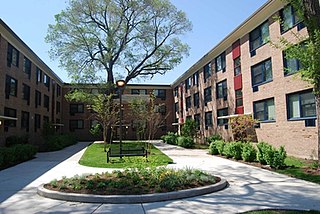
Wentworth Gardens is a low rise 344-unit housing project operated by the Chicago Housing Authority (CHA). It lies just south of Guaranteed Rate Field in Bronzeville on Chicago's south side.
